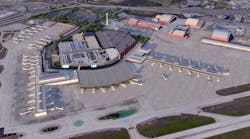I recently moderated HNTB Corporation’s first THINK: Infrastructure Forum focusing on how security standards impact international airport terminal design. Held in a virtual format, this national discussion series brings together top infrastructure experts on a variety of timely and critical topics facing the industry. The 90-minute event drew a high-profile panel of airport managers and security experts, U.S. Customs and Border Protection personnel and an audience of industry thought leaders.
Panelists discussed how high growth in U.S. international airports, evolving security standards and new technologies has significantly impacted airport terminal design and air travelers. It was noted that most passenger terminals were not originally designed to accommodate current screening and clearance processes, and facilities that are now so vital to aviation and national security.
As new trends and developments were discussed, such as secure sterile corridors and automated passport control kiosks for inbound passengers, key themes emerged:
- New technologies and mobile applications are evolving how passengers interact with the airport and airline, changing check-in, security and baggage claim processes.
- Automated Passport Control kiosks are making a big impact to Customs and Border Protection facilities and international terminals.
- Customs and Border Protection is spearheading a new process called “baggage first concept,” eliminating significant passenger wait time.
A Self-Serve Airport Terminal
In the not too distant future, airline agents in the airport terminal may be a thing of the past. Statistics show a historical shifting of how passengers check in for a flight, going from traditional agent assistance in the ticket lobby, to self-serve e-kiosks for boarding passes, to “remote” online check in, and now to a complete self-serve bag tag and check-in process.
Today, over 60 percent of passengers check in online, remote from the airport. Half of the remaining passengers use e-kiosks in the ticket lobby and less than 22 percent go to an agent at a ticket counter to complete the transaction of their checked bags.
Automated U.S. Customers and Border Protection Processing
Customs and Border Protection (CBP), as an agency of the Department of Homeland Security, has experienced reductions in staff due to federal budget cuts. Automated Passport Control kiosks eliminate the paper forms that arriving passengers must fill out upon entering the U.S. The new kiosks are much more efficient, reducing passenger queuing time and processing time by 33 percent.
In the future, passengers will be able to fill out forms electronically while on the aircraft en route to the U.S. airport destination through a mobile internet application, further reducing processing time.
More Efficient Baggage Systems
Technology improvements will also streamline the screening and processing of checked bags from the passenger drop location all the way to the belly of the aircraft. Technology exists that will enable luggage to be purchased with a permanent “kindle-type” GPS tracking tag electronically linked to the passenger. Both the airline and the passenger will be able to track the bag in real time with their respective mobile devices. From their aircraft seats, passengers will be able to confirm their bag is actually in the aircraft hold below, before the aircraft pushes back from the gate.
The Transportation Security Administration also is making advances in explosive detection screening technology for bags. This will reduce the number of expensive explosion detection devices required, while simultaneously processing an ever greater number of bags.
Industry Insights
Clearly, the model of how passengers and airlines use airport terminals today is in significant shift, with the most visible design changes related to new security requirements. The use of technology provides a method for airlines to connect with passengers through mobile devices and online commerce. Passengers are performing more transactions for themselves, such as checking in at home, self-checking bags and being continuously updated via their mobile devices.
Airport terminals of the future must integrate evolving security standards, embrace new technologies and focus on customer service for the passenger. However, the designer must be able to envision not only what is needed today, but anticipate what will be needed tomorrow.
National discussions such as this, which allow a network of airport experts to share knowledge and facilitate ongoing discussion, are essential to shaping the optimal solutions.
# # #
Tom Rossbach is the aviation architecture market leader for HNTB Corporation. He provides strategic direction for terminal projects within the national aviation market and has nearly 30 years of terminal planning and design experience. Contact him at (312) 446-1800 or [email protected].



